车辆工程专业英语概述
汽车工程专业英语第二章

第二章:内燃机(INTERNAL COMBUSTION ENGINE)1)Energy and power:Engines used in automobiles are internal combustion heat engines. They convert the chemical energy of the gasoline into heat within a power chamber that is called a combustion chamber. Heat energy released in the combustion chamber raises the temperature of the combustion gases within the chamber. The increase in gas temperature causes the pressure of the gases to increase. The pressure developed within the combustion chamber is applied to the head of a piston to produce a usable mechanical force, which is then converted into useful mechanical power.能源是用于生产电力。
化工能源是转化为燃料的燃烧的热量,这个过程被称为燃烧。
如果发动机燃烧发生在气缸内的地方,被称为发动机内部燃烧发动机。
如果燃烧发生在气缸外的地方,被称为发动机外部燃烧发动机。
用于汽车的能源叫内部燃烧高能源,高温能源在燃烧室里降低能缓解气体燃烧在气缸内的温度。
燃烧气体温度的升高引起气压变大,燃烧室内发展应用到了活塞产生一个可用的机械力,然后将其转换成有用的机械能。
2)Engine terms:Linking the piston by a connecting rod to a crankshaft causes the gas to rotate the shaft through half a turn. The power stroke "uses up" the gas, so means must be provided to expel the burnt gas and recharge the cylinder with a fresh petrol-air mixture: this control ofgas movement is the duty of the valves;活塞通过连杆和曲轴连接,使得气体带动曲轴旋转半圈。
车辆工程 汽车专业英语课件-汽车基础知识部分 - Chapter 4 Steering and Suspension Systems

Chapter 4 Steering and Suspension Systems
4.1 Steering System
Figure 4-4 Servolectric - a electric power steering system
Chapter 4 Steering and Suspension Systems
2.提高翻译技巧,能较熟练翻译课文
1. 重点:转向、悬架系统的基本组成、类型、 各系统主要零件的英文名称
2.难点:电动转向系统
Chapter 4 Steering and Suspension Systems
4.1 Steering System 1. Basic Parts of Steering System 2. Types of Steering System 3. Power Steering Systems 4.2 Suspension Systems 1. Basic Parts of Suspension System 2. Front suspension 3. Rear Suspension
1.Basic Parts of Steering System
The basic steering system (Figure 4-1) can be divided into three main assemblies:
·The spindle and steering arm assemblies. ·The linkage assembly connecting the steering arms and steering gear. ·The steering wheel, steering shaft, and steering gear assembly.
汽车专业英语的认识

汽车专业英语的认识汽车专业英语是汽车工程师和汽车技术人员在专业领域内交流和沟通的工具。
它并不仅仅是一种语言,而是与汽车技术紧密相关的专业语言。
学习汽车专业英语有助于学生和从业人员更好地理解和掌握汽车技术和汽车工程的基本概念。
以下是一些汽车专业英语的关键词和概念:1.Engine Terms(发动机术语)•Engine Block(发动机缸体)•Cylinder Head(气缸盖)•Pistons(活塞)•Connecting Rods(连杆)•Crankshafts(曲轴)2.TDC and BDC(上止点与下止点)•TDC(Top Dead Center,上止点)•BDC(Bottom Dead Center,下止点)3.VVT(可变气门正时)•Variable Valve Timing(可变气门正时)4.Valve Train(气门机构)•Valves(气门)•Camshafts(凸轮轴)•Cam followers(摇臂)•Valve springs(气门弹簧)5.Fuel Injection(燃油喷射系统)•Pumps(燃油泵)•injectors(喷油器)•Fuel rails(燃油导流管)6.Ignition System(点火系统)•Spark plugs(火花塞)•Coils(点火线圈)•distributor caps(分电器盖)7.Brake System(制动系统)•discs(刹车盘)•drums(刹车鼓)•calipers(卡钳)•Hydraulic pumps(液压泵)8.Cooling System(冷却系统)•Radiator(散热器)•Water pump(水泵)•Hoses(水管)•Fan belts(风扇皮带)9.Drive Train(传动系统)•Transmissions(变速器)•differentials(差速器)•Axles(车轴)•Tires(轮胎)学习汽车专业英语还需要了解一些缩写和术语,例如:FDI(燃油直接喷射)、MAP(进气压力传感器)、VVT-i(智能可变气门正时系统)、OBD(车载诊断系统)、CAD(计算机辅助设计)、CAM(计算机辅助制造)等。
车辆工程专业英语新能源汽车综述
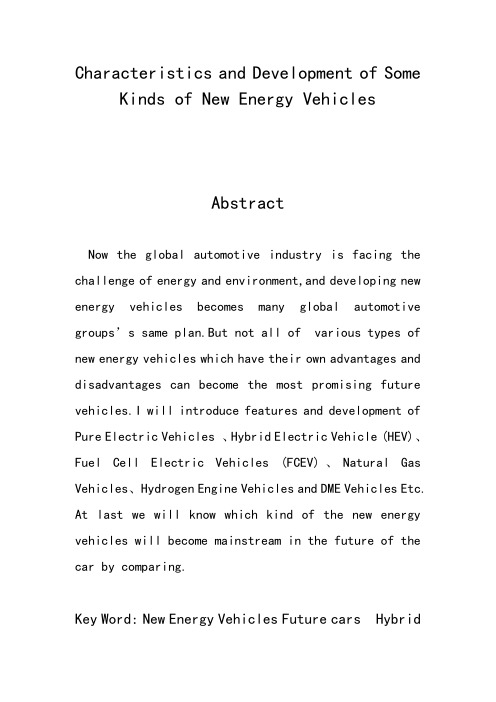
Characteristics and Development of Some Kinds of New Energy VehiclesAbstractNow the global automotive industry is facing the challenge of energy and environment,and developing new energy vehicles becomes many global automotive groups’s same plan.But not all of various types of new energy vehicles which have their own advantages and disadvantages can become the most promising future vehicles.I will introduce features and development of Pure Electric Vehicles 、Hybrid Electric Vehicle (HEV)、Fuel Cell Electric Vehicles (FCEV)、Natural Gas Vehicles、Hydrogen Engine Vehicles and DME Vehicles Etc. At last we will know which kind of the new energy vehicles will become mainstream in the future of the car by comparing.Key Word: New Energy Vehicles Future cars HybridHybrid cars is hybrid electric vehicles which use more than one kind of energy provides power to drives the car . Currently hybrid cars is the combination of traditional fossil fuels engin and electric motor. The most prominent advantage of hybrid cars is its fuel economy. The maximum power of the engin can determine by the average power ,so that the engin can work in less pollution and lower fuel consumption condition. That makes hybrid cars save 30%~50% fule compare with traditional cars,and significantly reducing emissions at the same time.Energy recovering from braking become easy too.But the problem of hybrid car is it’s high price and basicly no fuel saving at long distance、high speed driving.At present, China's hybrid vehicle technology development fast, some models have been in the period of practical .Take the Roewe 750 of Shanghai Automotive Group for example ,it has already on sale.In the world wild,Toyota Prius hybrid car first introduced in Japan in 1997,and the other major automobile companies havelaunched their own hybrid products, such as the Honda Insight, GM Saturn VUE, Ford Escape and so on.With technical progress and expansion of production scale,the cost has dropped significantly.Pure electric vehicles is driven by electric motor, which is powered by car-carry battery,and meet the requirements of traffic safety regulations.Pure electric vehicle using a rechargeable battery , and the basic structure is not complicated.Electric generators and car batteries are one of the key components, among which the most critical is battery.Pure electric vehicles is not a new car, the electric car was born more than 100 years. At that time the electric car battery lifespan is short, the mileage is not high also. Then the electric car is relaced by the increasingly technology mature internal combustion engine car. But in the 1970 s, due to the stimulation of oil crisis, all countries in the world began to look for other energy to replace oil. The electric car is back in the line of sight of people. And in recent years besides had the problems of energy, environmental problem has become a social focus on major issues. Againincreased focus on electric cars. Now the difficulty of promote puer electric car comes from the power storage technologies.Currently,energy storage in per unit weight of the battery is not enough for long -term using, the charge mileage is not ideal. On the other hand,The high-performance battery lifespan is short.Resulting in not froming economy scale, cost of pure electric vehicle is too high to commercial operation.Nevertheless, pure electric vehicles are promoted in the U.S., Europe, Japan in small-scale,and mainly use in government vehicle ,city bus Etc. The forerunner of China's electric car company BYD launched E6, and also exported electric bus to Europe .Fuel cell electric vehicle use a fuel cell as electric source to supply electric motor, and the chemical energy of fuel is directly changed into electrical energy by the cell.The energy conversion efficiency of the fuel cell is 2 to 3 times higher than internal combustion engines, and fuel cells do not produce harmful chemical reaction products and make lower noise.In recent years, although the development of fuel cell vehicles technology has made significant progress in the world wild , but there are still some technical challenges, such as the integration of fuel cells,vehicle integration, industrialization and commercialization. It is worth mentioning that we are at the same level with developed countries in the field of fuel cell electric vehicle researching.Hydrogen engine vehicle power by the engin which is transform from the existing automobile internal combustion engine.In addition to the hydrogen engine car has the same advantages of less pollution, lower emissions, but also has other special advantages, such as lower requirements for hydrogen, high combustion performance, engine technology is mature and so on.But now hydrogen engine car facing with problems of preparation and storage of liquid hydrogen .Ability to effectively solve these two problems in short time will determine the prospects for the development of hydrogen engine vehicles.Natural gas vehicles to use natural gas as fuel .According to the chemical composition and morphology of natural gas ,it can be classified as three kinds of it ,like Compressed Natural Gas (CNG), Liquefied Natural Gas (LNG) and Liquefied Petroleum Gas . Because natural gas vehicles using natural gas as fuel, so it has some feature like low pollution, low cost and high security.But natural gas vehicles have lower power performance, not easy to carry compared with normal vehicle. And once put into Large-scale using, we must build the appropriate station and pipeline.It also relates to design urban planning, funding and environmental safety, and many other factors, causing the high cost of using this kind of vehicle.China is rich in natural gas resources, and natural gas vehicle technology developed rapidly in these years . For example, some taxi Changsha use Compressed Natural Gas engin.In addition to the above new energy vehicles, as well as,there is also a kind of vehicle using organic substance, such as alcohol, ether as fuel to power the car.Ethanol fuel is ethanol automotive gasoline, ethanol vehicle technology is relatively mature, thetraditional internal combustion engine can modification to adapt to different ethanol gasoline fuel. The rapid development of ethanol cars happen in United States, Brazil and other countries thanks to the rich ethanol resources, while China is still in its initial stage.DME car use DME as fuel of compression-ignition engine. Generally using in two ways: Firstly, using the dimethyl ether as an ignition-promoting secondly dimethyl ether used as the direct combustion of liquid to get power.Dimethyl ether automobile technology in China has made important progress, such as Shanghai automotive group has successfully developed in dimethyl ether city bus, and began the trial runThanks to internal combustion engine technology is now very mature, hybrid cars is ease of using , sustainability, reliability is better than that of other new energy cars, but its still use gasoline, diesel oil as a source of energy, so the hybrid vehicle can't represent the future type of car. And because the power can be obtained from a variety of one-off energy,do not worry about energy draining, so pure electric vehicle has broad application prospects. At the same time, pure electric vehicles has no pollution, makes lower noise, is high efficiency. These advantages make this type of electric car research and application is becoming a hot spot of the car industry, and our country also take electric vehicles as the main orientation of auto industry strategic transformation. Fuel cell vehicles, with its efficient green cleaning and life advantage to get the attention of many countries to continuously invest devotion, therefore the fuel cell car will also be important form of the cars of the future. For other types of new energy vehicles, because of the limitations of fuel supplying, can't be used in the large scale all over the world. And this kind of alternative fuel in the engine power performance, corrosion, storage and transportation difficulties, such as obvious shortcomings. This kind of new energy vehicles may will be the future regional auto supplement type.Comparing the above list of various types of new energy vehicles, pure electric vehicles will be themainstream of future automobiles, fuel cell vehicles will act as an important component in the future , and a hybrid car is the transition models before exhausting of petrochemical resources, other types of cars are supplement adjust measures to local conditions. Pure electric vehicles is the most promising new energy vehicles, and is strongly supported by the state.Now some electric vehicles is used in the urban public transport, major activities.We look forward to the clean traffic early arrival of the era.References[1]邹政耀,王若平.新能源汽车技术.北京:国防工业书版社,2012[2]石川宪二.新能源汽车技术及未来.康云龙,余开江译.北京:科学出版社,2012[3]冯景毅.基于48V电压平台解读比亚迪绿混技术.汽车之家网,2013[4]黄正桥.陈斌波:电动汽车是未来汽车发展的方向.汽车之家网,2011[5]Sperling, Daniel.Two Billion Cars:Driving Toward :Oxford University Press,2009[6].Ranjan K. Bose, S. Sundar, K.S. Nesamani .Clearing the air : better vehicles, better fuels.New Delhi : Tata Energy Research Institute,2000[7]Electric VW Up prices ,02 December 2013。
车辆工程-汽车专业英语课件-汽车基础知识部分---Chapter-3-Power-Train--3
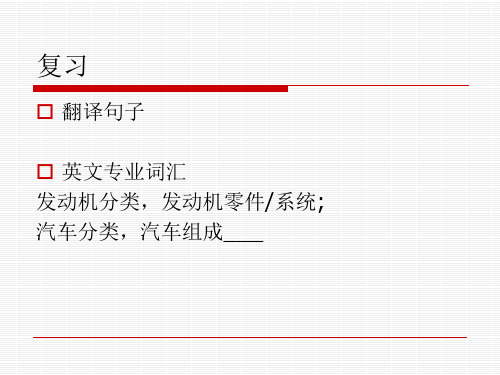
['flaiwi:l] [spriŋ] ['ɔpəreit] ['mekənizəm] [trænz'mi∫ən] [tɔ:k]
n.飞轮 n.弹簧 vt.操作,控制,使运行 n.(机械)结构,机械装置 n.变速器 n.扭转力;转矩
压盘
Chapter 3 Power Train 3.1 Clutches
摩擦式限滑差速器
Chapter 3 Power Train 3.2 Manuel Transmission
3.2.1 Text
1.Transmission Gear Ratios
The modern manual transmission can provide the driver with up to six forward gear ratios. The reduction gears provide gear ratios of approximately 3.5:1 (stated as 3.5 to 1) for the lowest gear, to about 1.5:1 for the highest. The direct drive gear has a 1:1 gear ratio. The overdrive gears have a gear ratio of about 0.7:1.
[ə'prɔksimə tli]
adv.近似地,大约;许
bearing
['bɛəriŋ] n.[机]轴承,支座
mesh
[me∫]
vi.(机器零件)啮合
transaxle
[ֽtræ ns'æ k sl]
n.变速驱动桥
汽车工程专业英语(汉化版)

Automotive Engineering English (Chinese Edition )汽车工程专业英语(汉化版)CONTENTSChapter 1 Automotive basics (2)1.1 The history of automotive (2)1.2 Classification of automotives (3)1.3 Principal Components (6)Review questions (13)Chapter 2 Engine (14)2.1 Overview (14)2.2 Engine construction (15)2.3 The engine operation (26)2.4 Basic engine systems (29)2.5 Air induction System (31)2.6 Gasoline fuel System (32)2.7 Engine Cooling (40)2.8 Engine Lubrication (44)2.9 Diesel engine (46)2.10 Emission Control (53)Review questions (61)目录第一章汽车的基础 (2)1.1 汽车的历史 (2)1.2. 汽车的分类 (3)1.3 汽车的主要组成部分 (6)复习题 (13)第二章发动机 (14)2.1 概述 (14)2.2 发动机的结构 (15)2.3 发动机的运转 (26)2.4 发动机的基本系统 (29)2.5 进气系统 (31)2.6 汽油供给系统 (32)2.7 发动机冷却系统 (40)2.8 发动机润滑系统 (44)2.9 柴油发动机 (46)2.10 排放控制 (53)复习题 (61)Capture 1 Automotive basis第一章汽车的基础1.1 The history of automobile1.1汽车的历史The automotive industry affects many areas of the economy. Starting with the first patented gasoline-powered Benz Motorwagen in 1886(Figure 1.1),the automotive industry has seen continuous and exciting changes for over a century. The early gasoline-powered automobile generated 1.5hp(1.1kW),it reaches top speed of 3~5mph(5~8km/h).Today's average vehicles have 110~450hp(80~330kW )engines and cruise at 106~120km/h,depending on the legal speed limit. For many people around the world,automotives are the most important means of personal transportation.汽车工业影响经济的许多领域。
车辆工程 汽车专业英语课件-汽车基础知识部分 - Chapter7 Electric Vehicles and Hybrid Electric Vehicles

7.1 Electric Vehicles (EVs)
roadster magnificent edifice
unveil
hydride electrochemical cadmium lithium titanate synchronous
New Words and Phrases
[ˈrəudstə(r)]
备受关注的特斯拉
特斯拉电动轿跑
技术领先的混动车
丰田普锐斯
Chapter 7 Electric Vehicles and Hybrid Electric Vehicles
Electric Vehicles (EV):
BEV
Battry
FCEV Fuel Cell
HEV
Hybrid
Hybrid Electric Vehicles(HEV): Petrol-electric Hybrid Diesel-electric Hybrid Plug-in Hybrid FCHEV
Vehicles with electric drives, consisting of batteries or fuel cells as the power source and electric motors as the prime mover, have attracted considerable attention in recent years,see Figure 7-1.
车辆工程专业英语复习资料资料讲解

车辆工程专业英语复习资料资料讲解车辆工程专业英语复习资料专业英语单词1.3-way catalyst 三元催化转化剂2.alternator 交流发电机3.Anti-lock brake system防抱死系统4.artic HGV=articulated HGV铰接式重型载货汽车5.articulated vehicle 铰接式车辆6.assembly 总成7.at right angle 成直角8.automatic transmission9.bearing 轴承10.bevel gear 锥齿轮11.bonnet 发动机盖12.bottom dead centre 下止点13.brake shoe 制动蹄14.bruise 撞伤,擦伤15.bulge 凸出,隆起16.bumper 保险杠17.caliper 制动钳18.camber 弯度,车轮外倾19.camshaft 凸轮轴20.canister 碳罐21.capacitor 电容器22.carbon monoxide 一氧化碳23.cargo 货物24.carriageway 车行道25.caster 主销后倾26.centrifugal 离心力27.charge 充电28.chassis 底盘29.clutch 离合器/doc/2310645824.html,mercial vehicle 商用车辆31.conductor 导体32.console 托架33.coolant 冷却剂34.countershaft 中间轴35.crankshaft 曲轴36.crossply tyre 斜交轮胎37.cross-sectional 截面的,断面的38.curvature 弯曲,弧度39.cylinder 气缸,柱体40.dial 刻度盘41.diaphragm 膜片42.differential 差速器43.dioxide 二氧化物44.disc brake 盘式制动器45.disc 圆盘46.discharge 放电47.DoT=D ep ar tmen t o f Transportation运输部门48.drawbar 牵引杆49.driven member 从动件50.driving member 主动件51.driving wheel 驱动车轮52.drum brake 鼓式制动器53.drum 鼓,圆筒54.dummy 模型,假人55.dump truck 自卸载货汽车56.dynamometer 测功机57.electron 电子58.engine 发动机59.executive 经理60.exhaust valve 排气阀61.final drive 主传动,主减速器62.flexible joint 万向节63.fracture 折断,骨折64.gear sector 齿扇65.Hall effect 霍尔效应66.handbrake 手制动67.helmet 头盔,安全帽68.HGV=Heavy Goods Vehicle 重型载货汽车69.horn 喇叭70.hydraulic system 液压系统71.hydrocarbon 碳氢化合物72.hydrocarbon 碳氢化合物73.ignition coil 点火线圈74.inflate 膨胀,加压75.injector 喷油器76.inlet valve 进气阀77.input shaft 输入轴78.instrument panel 仪表盘79.intersection 交叉口80.inversely proportional to 与……成反比81.king pin 主销/doc/2310645824.html,cerationn 划破,撕裂83.LCV=Light Commercial Vehicle轻型商用车辆84.LGV=Light Goods Vehicle轻型载货汽车85.logistics 后勤学,物流86.lubricant 润滑剂87.manifold 歧管,支管88.master cylinder 主缸89.metro 地下铁道90.monoxide 一氧化物91.moped 机动自行车92.mpg=miles per gallon 英里/加仑93.mph=miles per hour 英里/小时94.neutral steer 中性转向95.nose-to-tail collision 头尾相撞96.occupant 占有者,乘员97.off-centre 偏心的,不平衡的98.oil filter 机油滤清器99.oil pump 机油泵100.output shaft 输出轴101.oversteer 过度转向102.overtake 超车103.overturn 翻车104.oxide 氧化物105.oxides of nitrogen 氮氧化物106.pattern tread 花纹胎面107.pessess 具有,拥有108.piston 活塞109.planet gear 行星齿轮110.pneumatic 气动的111.pollision 碰撞,冲突112.power steering 动力转向仅供学习与交流,如有侵权请联系网站删除谢谢2113.pressure plate 压盘114.propellor shaft 传动轴115.PSV=Passenger Single Vehicle 单体式客运车辆116.radial tyre 子午线轮胎117.rake pad 制动片118.recharge 再充电119.refrigerate 制冷120.resurgence 苏醒,复活121.ring gear 齿圈122.rocker 摇臂123.roller brake testes 滚筒制动试验台124.rotor转子125.shock absorber 减震器126.shoulder 路肩127.sill 底梁128.slave cylinder 辅助缸129.smooth tread 无纹胎面130.spark plug 火花塞131.speedometer 速度计,里程计132.sprain 扭伤133.starter 起动机134.stator 定子135.steering arm 转向臂,梯形臂136.steering assembly 转向总成137.steering axis inclination 主销内倾138.steering column 转向柱139.steering knuckle 转向节140.steering pump转向泵141.steering wheel 转向盘142.sulphide 硫化物143.sun gear 太阳轮144.suspension 悬架145.tachograph 转速表146.tanker 油罐汽车147.the moment of inertia 转动惯量148.the three way catalytic converter 三元催化转化器149.thermostat 恒温器,节温器150.throttle 节流阀151.tie rod 横拉杆152.toe-in 前束153.tolerance 公差154.top dead centre 上止点155.torque converter 变矩器156.torque convertor 变矩器157.torque 转矩,扭矩158.tractor 拖拉机,牵引车159.trailer 挂车,拖车160.transmission 传动系161.truck deck 行李舱盖162.turbine 涡轮(机)163.twin wheel 双轮胎164.understeer 不足转向165.universal joint 万向节166.vechicle dismantling 车辆分解167.vehicle tracking system车辆跟踪系统168.washer 洗涤器169.windscreen 风窗玻璃170.wiper 刮水器171.wormwheel蜗轮自动变速器仅供学习与交流,如有侵权请联系网站删除谢谢3专业英语句子翻译1.Each wheel has a brake assembly, of either thedrum type or the disc type, hydraulically operated when the driver applies the foot brake pedal.每个车轮具有一个鼓式或盘式制动总成,当驾驶员踩脚制动踏板时,靠液力产生制动。
汽车工程专业英语 全文翻译
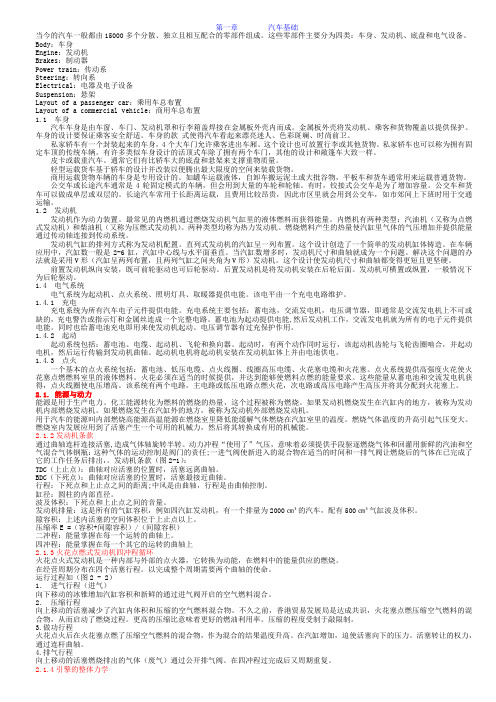
第一章汽车基础当今的汽车一般都由15000多个分散、独立且相互配合的零部件组成。
这些零部件主要分为四类:车身、发动机、底盘和电气设备。
Body:车身Engine:发动机Brakes:制动器Power train:传动系Steering:转向系Electrical:电器及电子设备Suspension:悬架Layout of a passenger car:乘用车总布置Layout of a commercial vehicle:商用车总布置1.1 车身汽车车身是由车窗、车门、发动机罩和行李箱盖焊接在金属板外壳内而成。
金属板外壳将发动机、乘客和货物覆盖以提供保护。
车身的设计要保证乘客安全舒适。
车身的款式使得汽车看起来漂亮迷人、色彩斑斓、时尚前卫。
私家轿车有一个封装起来的车身,4个大车门允许乘客进出车厢。
这个设计也可放置行李或其他货物。
私家轿车也可以称为拥有固定车顶的传统车辆。
有许多类似车身设计的活顶式车除了拥有两个车门,其他的设计和敞篷车大致一样。
皮卡或载重汽车。
通常它们有比轿车大的底盘和悬架来支撑重物质量。
轻型运载货车基于轿车的设计并改装以便腾出最大限度的空间来装载货物。
商用运载货物车辆的车身是专用设计的。
如罐车运载液体,自卸车搬运泥土或大批谷物,平板车和货车通常用来运载普通货物。
公交车或长途汽车通常是4轮固定模式的车辆,但会用到大量的车轮和轮轴。
有时,铰接式公交车是为了增加容量。
公交车和货车可以做成单层或双层的。
长途汽车常用于长距离运载,且费用比较昂贵,因此市区里就会用到公交车,如市郊间上下班时用于交通运输。
1.2 发动机发动机作为动力装置。
最常见的内燃机通过燃烧发动机气缸里的液体燃料而获得能量。
内燃机有两种类型:汽油机(又称为点燃式发动机)和柴油机(又称为压燃式发动机)。
两种类型均称为热力发动机。
燃烧燃料产生的热量使汽缸里气体的气压增加并提供能量通过传动轴连接到传动系统。
发动机气缸的排列方式称为发动机配置。
车辆工程专业英语复习资料
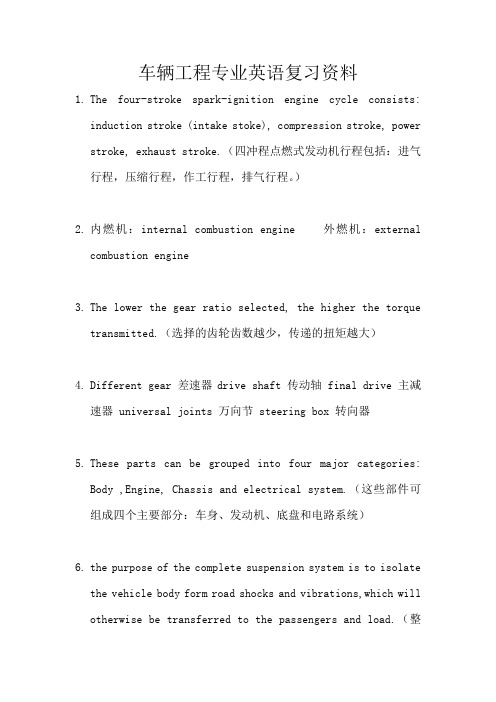
车辆工程专业英语复习资料1.The four-stroke spark-ignition engine cycle consists:induction stroke (intake stoke), compression stroke, power stroke, exhaust stroke.(四冲程点燃式发动机行程包括:进气行程,压缩行程,作工行程,排气行程。
)2.内燃机:internal combustion engine 外燃机:externalcombustion engine3.The lower the gear ratio selected, the higher the torquetransmitted.(选择的齿轮齿数越少,传递的扭矩越大)4.Different gear 差速器drive shaft 传动轴 final drive 主减速器 universal joints 万向节 steering box 转向器5.These parts can be grouped into four major categories:Body ,Engine, Chassis and electrical system.(这些部件可组成四个主要部分:车身、发动机、底盘和电路系统)6.the purpose of the complete suspension system is to isolatethe vehicle body form road shocks and vibrations,which will otherwise be transferred to the passengers and load.(整个悬架系统的目的是分离车身来自路面的冲击和振动,否则会被传递给乘客和货物。
)7.tube tires 有内胎轮胎 drum brakes鼓式制动器 discbrakes盘式制动器8.most modern lighe vehicles have either disc brakes on thefront wheels and drum brakes on the rear or disc brakes on all 4 wheels大多数现代光车是前轮采用盘式制动鼓上的所有4个车轮后面或盘式制动器制动器9.the electrical system supplies electricity for thestarter,ignition,lights and heater电气系统为起动机、点火系统、照明灯具、取暖器提供电能10.the sparks must be supplied at the right time and theysufficient energy over a range of conditions to ignite the charges火花必须在正确的时间提供足够的能量,他们在一系列的条件下点燃的指控11.distributor分电器 spark plug 火花塞12.Energy is used to produce power. The chemical energy infuel is converted to heat by the burning of the fuel at a controlled rate.(能量是用来产生动力的,燃料中的化学能通过控制其比例进行燃烧可转化成热能。
汽车工程专业英语(汉化版)

Automotive Engineering English (Chinese Edition )汽车工程专业英语(汉化版)CONTENTSChapter 1 Automotive basics (2)1.1 The history of automotive (2)1.2 Classification of automotives (3)1.3 Principal Components (6)Review questions (13)Chapter 2 Engine (14)2.1 Overview (14)2.2 Engine construction (15)2.3 The engine operation (26)2.4 Basic engine systems (29)2.5 Air induction System (31)2.6 Gasoline fuel System (32)2.7 Engine Cooling (40)2.8 Engine Lubrication (44)2.9 Diesel engine (46)2.10 Emission Control (53)Review questions (61)目录第一章汽车的基础 (2)1.1 汽车的历史 (2)1.2. 汽车的分类 (3)1.3 汽车的主要组成部分 (6)复习题 (13)第二章发动机 (14)2.1 概述 (14)2.2 发动机的结构 (15)2.3 发动机的运转 (26)2.4 发动机的基本系统 (29)2.5 进气系统 (31)2.6 汽油供给系统 (32)2.7 发动机冷却系统 (40)2.8 发动机润滑系统 (44)2.9 柴油发动机 (46)2.10 排放控制 (53)复习题 (61)Capture 1 Automotive basis第一章汽车的基础1.1 The history of automobile1.1汽车的历史The automotive industry affects many areas of the economy. Starting with the first patented gasoline-powered Benz Motorwagen in 1886(Figure 1.1),the automotive industry has seen continuous and exciting changes for over a century. The early gasoline-powered automobile generated 1.5hp(1.1kW),it reaches top speed of 3~5mph(5~8km/h).Today's average vehicles have 110~450hp(80~330kW )engines and cruise at 106~120km/h,depending on the legal speed limit. For many people around the world,automotives are the most important means of personal transportation.汽车工业影响经济的许多领域。
车辆工程专业英语
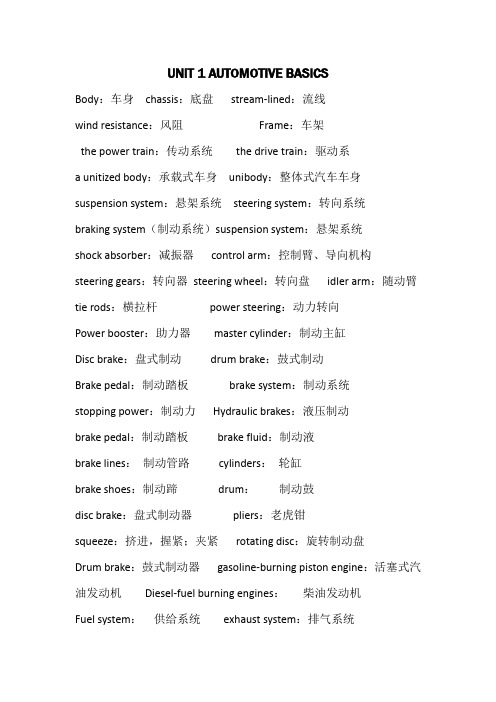
UNIT 1 AUTOMOTIVE BASICSBody:车身chassis:底盘stream-lined:流线wind resistance:风阻Frame:车架the power train:传动系统the drive train:驱动系a unitized body:承载式车身unibody:整体式汽车车身suspension system:悬架系统steering system:转向系统braking system(制动系统)suspension system:悬架系统shock absorber:减振器control arm:控制臂、导向机构steering gears:转向器steering wheel:转向盘idler arm:随动臂tie rods:横拉杆power steering:动力转向Power booster:助力器master cylinder:制动主缸Disc brake:盘式制动drum brake:鼓式制动Brake pedal:制动踏板brake system:制动系统stopping power:制动力Hydraulic brakes:液压制动brake pedal:制动踏板brake fluid:制动液brake lines:制动管路cylinders:轮缸brake shoes:制动蹄drum:制动鼓disc brake:盘式制动器pliers:老虎钳squeeze:挤进,握紧;夹紧rotating disc:旋转制动盘Drum brake:鼓式制动器gasoline-burning piston engine:活塞式汽油发动机Diesel-fuel burning engines:柴油发动机Fuel system:供给系统exhaust system:排气系统Cooling system:冷却系统lubrication system:润滑系统ignition system:点火系统electric spark:电火花air-fuel mixture:可燃混合气cylinder:汽缸ignition switch:点火开关current:电流storage battery:蓄电池ignition coil:点火线圈Distributor:分电器spark plug:火花塞compression ignition engines:压燃式发动机charging circuit:充电电路regulator:电压调节器alternator (or generator):发电机mechanical energy:机械能electrical energy:电能maximum voltage:最大电压fuel system:燃料供给系统fuel pump:燃油泵Filter:滤清器carburetor:化油器fuel injection system:燃油喷射系统combustible mixture:可燃混合气manifold:进气管exhaust system:排气系统carbon monoxide:一氧化碳hydrocarbons(碳氢化合物)oxides of nitrogen:氮氧化合物emission control system:排放控制系统cooling system:冷却系统combustion chamber:燃烧室coolant:冷却液Radiator:散热器water pump:水泵hollow:空的、空洞的block:汽缸体head:汽缸盖Defroster:(除冰(或霜)装置)lubrication system:润滑系统lubricant:润滑剂piston rings:活塞环cylinder walls:汽缸壁oil filter:机油滤清器Transmission:变速器wheel bearings:车轮轴承differential:差速器steering linkage:转向链接机构power train:传动系统transmission:变速器shift lever:变速杆clutch:离合器Transmission:变速器torque:转矩Differential:差速器drive /propeller shaft:传动轴universal joints:万向节axle movement:轴向运动flexible universal joints:活动万向节Differential:差速器UNIT 2 AUTOMOTIVE ENGINEinternal combustion engine:内燃机liquefied petroleum gas(LPG):液化石油气Compressed natural gas(CNG):压缩天然气drive shaft:驱动轴rear-wheel-drive arrangement:后轮驱动布置形式front-wheel-drive arrangement:前轮驱动布置形式drive wheels:驱动轮mid-engine arrangement:发动机中置Pistons:活塞reciprocate:往复spark ignition engine:火花点燃式发动机compression ignition(CI) engine:压燃式发动机electric ignition system:电子点火系统spark plug:火花塞ignite:点燃cylinders:气缸combustion:燃烧compression-ignition engine:压燃式发动机diesel engine:柴油机Spray:喷入heavy-duty trucks:重型货车spark-ignition engine:火花点燃式发动机fuel system:燃料供给系统ignition system:点火系统lubricating system:润滑系统cooling system:冷却系统fuel system:燃料供给系统combustible mixture:可燃混合物air/fuel mixture:空气燃料混合气ignition system:点火系统spark plug:火花塞air/fuel mixture:可燃混合气lubricating oil:润滑油lubricating system:润滑系统oil pan:油底壳oil pump:机油泵reservoir:贮存器; 油箱exhaust gas:排气cooling system:冷却系统exhaust system:排气系统emission-control system:排放控制系统starting system:启动系统Crank:转动曲柄starting motor:启动马达internal combustion engine:内燃机chemical energy:化学能heat energy:热能mechanical energy:机械能air/fuel ratio:空燃比Diesel engines:柴油机intake:进气connecting rod:连杆crankshaft:曲轴reciprocating movement/back and forth movement/up and down movement(往复运动)rotary motion/ turning motion:(旋转运动)crankshaft:曲轴Efficiency:效率potential energy:潜能mechanical energy:机械能overall efficiency:总效率compression ratio:压缩比air/fuel ratio:空燃比uppermost position/(TDC, top dead center:上止点lowest position/BDC, bottom dead center:下止点stroke:行程four stroke-cycle Gasoline Engine:intake stroke:进气行程compression stroke:压缩行程power stroke:作功行程exhaust stroke:排气行程revolution:转、圈crankshaft:曲轴camshaft:凸轮轴Crankshaft:曲轴connecting rod:连杆intake valve:进气门camshaft:凸轮轴pressure difference:压力差air/fuel mixture:空气/燃料混合气compression ratio:压缩比TDC:上止点exhaust valve:排气门exhaust gases:废气starter motor:启动马达ignition key:点火钥匙start position:启动位置Flywheel:飞轮UNIT 3 AUTOMOTIVE LUBRICATION SYSTEM(汽车润滑系统)3.1 Lubrication Principles 润滑原理Friction:摩擦primary job:基本任务Residual oil:残留的机油Lubricant:滑润剂hydrodynamic:液力的oil adhesion:机油粘度sliding friction:滑动摩擦Pressure-Lubrication System压力润滑系统oil pan:油底壳block:汽缸体oil pump:油泵drain plug:放油螺塞oil-pan gasket:油底壳垫圈Passageway:油道oil filter:机油滤清器Crankcase:曲轴箱tube:管filter screen:滤网gear-type:齿轮泵rotor-type:转子泵full-flow filtering system:全流式滤清器pressure-relief valve:安全阀bypass valve:旁通阀camshaft(凸轮轴)main bearing:主轴承camshaft bearing:凸轮轴轴承Foam inhibitor:泡沫抑制剂UNIT 4 THE COOLING SYSTEM(冷却系统)exhaust system:排气系统cylinder wall:汽缸壁piston:活塞cylinder head:汽缸盖oil film:油膜fuel mileage:燃油经济性exhaust emissions:废气排放liquid cooling:水冷air cooling:风冷water jacket:水套thermostat:节温器water pump:水泵radiator:散热器radiator cap:散热器盖cooling fan:冷却风扇hoses:软管expansion tank:膨胀水箱overflow tank:溢流水箱4.1 Water Pump(水泵)centrifugal pump:离心泵centrifugal force:离心力4.2 Water Jacket(水套)hot spot:热点valve seat:气门座valve guide:气门导管cylinder wall:汽缸壁combustion chamber:燃烧室4.3 Radiator(散热器)heat exchanger:热交换器4.4 Pressure Cap(散热器盖)boiling point:沸点pressure release valve:减压阀, 安全阀overflow tube:溢流管overflow tank:溢流箱4.5 Thermostat(节温器)4.6 Fancooling fan:冷却风扇constant temperature:常温thermostatic switchUNIT 5 FUEL INJECTION SYSTEMFuel injection system:燃油喷射系统purely mechanical:纯机械的electronic fuel injection system:电子燃油喷射系统feedback control:反馈控制emission:排放solenoid valve:电磁阀injector:喷油器best power:最佳动力性best emission:最佳排放性best economy:最佳经济性rich condition:浓(混合气)工况lean condition:稀(混合气)工况5.3 Fuel System(燃油系统)fuel rail:油轨regulator:压力调节器return line:回油管fuel manifold:燃油歧管intake manifold:进气歧管5.4 Air Metering and Measurement 空气计量butterfly valve:传统碟形阀throttle body assembly:节气门体总成Mass Airflow:质量流量Speed Density:速度密度spring loaded flap:翼片potentiometer:电位计heated wire:加热电阻丝voltage signal:电压信号5.5 Most EFI systems measure the same basic 6 input大多数EFI系统检测6个基本输入(信号)RPM(转速) ignition coil:点火线圈magnetic sensor:磁脉冲传感器Hall effect sensor:霍尔效应传感器Manifold Pressure (进气歧管压力) Throttle Position (节气门位置)Water Temperature injector pulse width:喷油器脉冲宽度Air Temperature5.6 Oxygen Sensor(氧传感器)closed loop systems:闭环系统oxygen content:氧含量air/fuel ratio:空燃比open loop mode:开环模式UNIT 6 EXHAUST SYSTEMexhaust system:排气系统Exhaust gas:废气combustion chamber:燃烧室muffler:消声器catalytic converter:催化转换器6.2 The Muffler(消声器)backpressure:背压exhaust valve:排气门6.3 The Exhaust Manifold and Headerexhaust manifold:排气歧管cylinder head:气缸盖intake manifold:进气歧管UNIT 7 THE IGNITION SYSTEM(点火系统)breaker point type ignition system:触点型点火系统electronic ignition system:电子点火系统distributorless ignition system:无分电器点火系统)timing of the spark plug firing:火花塞点火次序spark plug gap:火花塞间隙7.1 Point-Type Ignition System(触点型点火系统)electrical circuit:电路primary circuit:初级回路secondary circuit:次级回路breaker point:触点ignition switch:点火开关secondary winding:次级线圈high-tension lead:高压导线distributor:分电器coil:点火线圈distributor cap:分电器盖distributor rotor:分火头controlling element:控制元件primary current:初级电流Distributor:配电器7.2 Electronic Ignition Systems(电子点火系统)electronic control module:电子控制模块7.3 Distributorless Ignition Systems (DIS) (无分电器点火系统)spark timing:点火正时Ignition Control Unit (ICU):点火控制单元Engine Control Unit (ECU):发动机控制单元firing order:点火顺序Top Dead Center (TDC):上止点UNIT 8 CLUTCHdrive line/drive train:传动系统Clutch:离合器transmission:变速器drive shaft:传动轴final drive assembly:主减速器总成clutch disc:离合器片pressure plate:压盘pressure plate cover:离合器盖friction mechanism:摩擦机构engine torque:发动机扭矩gear ratio:传动比clutch pedal:离合器踏板driven member:从动件transmission input shaft:变速器输入轴driving members:主动件crankshaft:曲轴torsional shock:扭转振动starter motor:启动马达splined hub:花键毂spline:花键transmission input shaft:变速器输入轴diaphragm spring:膜片弹簧centrifugal force:离心力release bearing:分离轴承disengagement mechanism:分离机构hydraulic system:液压系统hydraulic mechanism:液压机构clutch master cylinder:离合器主缸hydraulic fluid:制动液clutch release cylinder:离合器分离缸UNIT 9 AUTOMATIC TRANSMISSION(自动变速器)fluid coupling(液力偶合器)torque converter(变矩器rear wheel drive(后轮驱动)front wheel drive(前轮驱动).drive shaft(驱动轴)final drive(主减速器)rear axle(后轴)rear wheels(后轮)transaxle(驱动桥)Front axles(前桥)planetary gear sets(行星齿轮组)hydraulic system(液力系统)Planetary gear sets(行星齿轮组)sun gear(太阳轮)ring gear(齿圈)planet gears(行星轮)constant mesh(常啮合common carrier(行星架)input shaft(输入轴)output shaft(输出轴)9.2 Clutch pack(离合器组)clutch drum(离合器鼓)friction material(摩擦材料)9.3 One-Way Clutch(单向离合器)"sprag" clutch(超越离合器)neutral(空挡)9.4 Bands(制动带)9.5 Torque Converter(液力变矩器)(见阅读材料)UNIT 10 THE DIFFERENTIAL(差速器)unlimited-slip, differential:不防滑差速器10.1 The Main Gears(主减速器)bevel gear:锥齿轮axle shaft:半轴final drive assembly:主减速器总成gear reduction:减速drive wheel:驱动轮drive shaft:传动轴spiral bevel gear:螺旋锥齿轮center line(centerline):中心线10.2 The Differential System(差速系统)axle shaft:半轴side gear:半轴齿轮UNIT 11 BRAKE SYSTEM(制动系统)kinetic energy:惯性能量momentum:动量thermal energy (heat):热能master cylinder:主缸brake pedal:制动踏板mechanical pressure:机械压力hydraulic pressure:液体压力brake line:制动管brake hose:制动软管slave cylinder:轮缸Brake fluid:制动液Shoe:制动蹄pad:制动块drums:制动鼓rotor:制动盘disk brake:盘式制动器drum brakes:鼓式制动器caliper:制动嵌brake shoe:制动蹄friction lining:摩擦衬片friction surface:摩擦表面emergency brake:紧急制动Power brake booster:动力制动助力器master cylinder:制动主缸brake pedal:制动踏板hydraulic actuator:液压传动机构wheel speed sensor:车轮速度传感器UNIT 14 ABS AND TCS14.1 Braking System Fundamentals,master cylinder:主缸wheel cylinders:轮缸caliper pistons:制动钳活塞rolling energy:旋转能量14.2 Antilock Braking Systems(防抱死制动系统)retarding force:制动力percent slip滑移率braking effectiveness:制动效能wheel speed sensors (WSS):车轮速度传感器Reading material-Torque Converter-术语Torque Converter(液力变矩器)manual transmission:自动变速器automatic transmission:自动变速器brake pedal:制动踏板gas pedal:加速踏板 1. Pump(泵轮).2. Turbine(涡轮).3. Stator(导轮).4. Transmission fluid(传动液).Freewheel:自由轮lockup clutch:锁止离合器。
车辆工程知识点总结
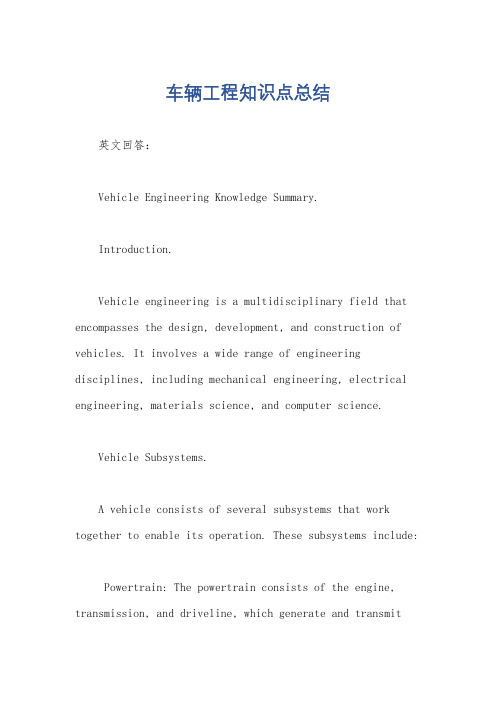
车辆工程知识点总结英文回答:Vehicle Engineering Knowledge Summary.Introduction.Vehicle engineering is a multidisciplinary field that encompasses the design, development, and construction of vehicles. It involves a wide range of engineering disciplines, including mechanical engineering, electrical engineering, materials science, and computer science.Vehicle Subsystems.A vehicle consists of several subsystems that work together to enable its operation. These subsystems include:Powertrain: The powertrain consists of the engine, transmission, and driveline, which generate and transmitpower to the wheels.Chassis: The chassis provides the structural supportfor the vehicle and houses the wheels, suspension, and brakes.Body: The body protects the occupants from theelements and provides aerodynamic efficiency.Electrical System: The electrical system powers the vehicle's lights, accessories, and electronic control units.Control Systems: Control systems ensure the safe and efficient operation of the vehicle by monitoring and adjusting its behavior.Vehicle Design.The design of a vehicle is a complex process that requires consideration of numerous factors, including:Vehicle Type: The type of vehicle (e.g., car, truck,motorcycle) determines its basic configuration and performance requirements.Performance: The desired performance of the vehicle, such as speed, acceleration, and fuel consumption, influences the design of its subsystems.Safety: Safety is a primary concern in vehicle design, and engineers employ various technologies to minimize the risk of accidents and injuries.Environmental Impact: The design of a vehicle must consider its environmental impact, including emissions,fuel consumption, and materials used.Vehicle Testing.Testing is an integral part of vehicle development. Engineers conduct various tests to ensure that the vehicle meets design specifications and performs as expected. These tests include:Bench Testing: Bench testing involves testing individual components or subsystems on a test stand.Vehicle Testing: Vehicle testing involves testing the complete vehicle on a test track or in real-world conditions.Crash Testing: Crash testing is used to evaluate the vehicle's safety performance in the event of an accident.Vehicle Manufacturing.Vehicle manufacturing is a complex and highly automated process. It involves a variety of techniques, including:Stamping: Stamping is used to shape metal parts, such as body panels.Welding: Welding is used to join metal parts together.Assembly: Assembly involves putting together the various components of the vehicle.Painting: Painting is used to protect the body from corrosion and to improve its appearance.Conclusion.Vehicle engineering is a challenging and rewarding field that requires a deep understanding of engineering principles and a passion for innovation. Engineers in this field are responsible for designing, developing, and building vehicles that are safe, efficient, and environmentally friendly.中文回答:车辆工程知识点总结。
汽车专业英语

车辆工程专业汽车专业英语KEY WORDS (一)汽车automobile 拖拉机tractor 军用车辆military vehicle轿车car 客车bus, coach 货车truck, lorry半挂牵引车tractor-truck 公路用车road vehicle 非公路用车off-road vehicle乘用车passenger car 商用车commercial vehicle 敞篷车convertible私家轿车sedan 铰接客车articulated bus 厢式货车van truck自卸汽车dump truck (tripper) 半挂车trailer 汽车列车tractor-trailer发动机engine 汽油机gasoline engine 柴油机diesel engine内燃机internal combustion engine 气缸cylinder 底盘chassis传动系power train 行驶系running gea r 转向系steering system制动系braking system 离合器clutch 变速器gear box (transmission)传动轴propeller shaft (drive shaft) 驱动桥drive axle(transaxle) 主减速器final drive差速器differential gear 车架frame 悬架suspension车轮wheel 转向盘steering wheel 转向器steering gearbox转向传动装置steering linkage 制动器brake 减震器shock absorber钢板弹簧leaf spring 螺旋弹簧coil spring 扭力杆torsion bar斜交轮胎cross-ply tire 子午线轮胎radial tire 有内胎轮胎tube tire无内胎轮胎tubeless tire 轮毂wheel hub 制动蹄 brake shoe鼓式制动器 drum brake 盘式制动器disc brake 行车制动service brake紧急制动emergency brake 驻车制动park brake 起动机starter交流发电机alternator 活塞piston 连杆connecting rod曲轴 crankshaft 飞轮flywheel 进气门intake valve排气门 exhaust valve 燃烧室combustion chamber 上止点(TDC)top dead center下止点 (BDC) bottom dead center 活塞行程stroke 汽缸直径bore排量swept volume, displacement 发动机排量engine capacity 燃烧室容积 clearance volume 压缩比compression ratio进气行程 intake stroke 压缩行程compression stroke做功行程working stroke 排气行程exhaust stroke发动机缸体engine block 曲柄连杆机构crankshaft and connecting rods system配气机构 valve system 燃油供给系统 fuel system点火系统 ignition system 起动系统 starting system冷却系统 cooling system 润滑系统 lubrication system发动机前置后轮驱动(FR) front engine rear drive 全轮驱动(nWD)all wheel drive发动机前置前轮驱动(FF) front engine front drive发动机后置后轮驱动(RR)rear engine reardrive 发动机中置后轮驱动(MR) middle engine rear driveKEY WORDS (二)water jackets水套oil gallery 油道camshaft凸轮轴gray iron灰铸铁overhead-cam engines顶置凸轮(OHC)发动机Piston ring活塞环Dry cylinder sleeve干式缸套Wet cylinder sleeve 湿式缸套Wear and Tear 磨损Rebore n. 1. 重镗vt. 1. 镗大(内燃机气缸)的孔径Flush nut 平头螺母Wear well 经久耐用valve springs 气门弹簧rocker摇臂rocker shaft摇臂杆valve gear气门传动机构push-rod推杆High tensile steel stud 高强度螺栓Crankcase 曲轴箱Cylinder wall 气缸壁piston ring活塞环piston groove 活塞环槽Piston pin 活塞销Pin boss 活塞销凸台piston top (crown) 活塞顶piston head活塞头部piston skirt活塞裙ring land活塞环带slot开槽compression ring气环Oil ring油环Small-end of connecting rod连杆小头Big end of connecting rod连杆大头Big-end shell bearing连杆轴瓦Big-end cap连杆盖main bearing journals主轴颈main bearing主轴承connecting rod journals (crank pin )连杆轴颈(曲柄销)main bearing journals主轴颈flywheel飞轮Crank曲柄Over Head Camshaft valve train顶置凸轮轴气门传动Timing gear正时齿轮Push rod valve train下置式凸轮轴气门传动Over Head Valve顶置气门(OHV) Over Head Camshaft顶置凸轮轴(OHC) valve guide气门导管valve clearance气门间隙Balance weight(counter weight) 配重valve stem气门杆Single Over Head Camshaft单顶置凸轮轴(SOHC) valve seat气门座Dual Over Head Camshaft双顶置凸轮轴(DOHC) valve spring气门弹簧tappet挺柱cam follower 从动凸轮push rod推杆cam lobe凸轮突起rocker ar摇臂rocker shaft摇臂轴valve clearance adjuster气门间隙调整feeler gauge测隙规screwdriver螺丝刀ring spanner梅花双头扳手Valve timing 气门正时timing phase配气相位retard angle 延迟角advance angle 提前角Gear drive 齿轮传动Chain drive 链传动Belt drive 带传动cold start冷起动post-start phase后起动阶段warm-up暖机acceleration加速part load部分负荷full load 全负荷idling怠速engine-speedlimiting发动机限速overrun超速adaption of the air-fuel mixture at high altitude高海拔处燃油混合气的调整excess-air factor过量空气系数fuel pump 汽油泵Fuel tank 油箱Electric fuel pump 电子油泵Fuel filter 燃油滤清器Fuel-injection valve 喷油器Ignition coil 点火线圈Fuel rail and pressure regulator 燃油管和油压调节器High-tension distributor 高压分电器Spark plug 火花塞Throttle valve 节气门Throttle valve switch 节气门开关Air-flow sensor 空气流量计Engine speed and reference-mark sensor 发动机速度和位置传感器Engine temperature sensor 发动机温度传感器Lambda sensor 氧传感器Air temperature sensor 进气温度传感器Rotary idle actuator 怠速执行器Ignition and starting switch点火和起动开关Exhaust gas recirculation 废气再循环Air-conditioning switch 空调开关EFI=electronic fuel injection 电控燃油喷射MPI= Multi-point injection 多点喷射SPI=single-point injection单点喷射GDI=gasoline direct injection汽油缸内直喷KEY WORDS (三)输油泵fuel supply pump(feed pump) 喷油泵fuel injection pump 喷油器injector 精密偶件precise couple 柱塞plunger 柱塞套plunger barrel 出油阀delivery valve 出油阀座delivery valve seat 针阀needle valve 针阀体needle valve body 调速器governor 综合调速器combination governor 全程式调速器variable-speed governor 飞块flyweight 涡轮增压器turbocharger 中间冷却器intermediate cooler 曲轴crankshaft 轴承bearing 离合器盘clutch disc 离合器盖clutch cover 压盘pressure plate钢支撑圈steel supporter 膜片弹簧diaphragm spring 回位弹簧return spring 分离轴承和分离套筒release bearing and release sleeve 离合器踏板clutch pedal 离合器轴clutch shaft (gear box primary shaft) 分离叉release fork 分离连接装置clutch linkage 调节叉adjustment fork 输入轴input shaft 滑动啮合变速器sliding-mesh transmission 常啮合变速器constant-mesh transmission 同步啮合变速器synchro-mesh transmission 中间轴counter shaft/ layshaft 主轴main shaft 倒档轴reverse idler shaft 换档机构selector mechanism 换挡杆gear lever 换档轴selector axle 换档叉selector fork 双脚离合double declutching 直齿圆柱齿轮spur gear 锁环friction cone 接合套dog clutchKEY WORDS (四)Disc brake盘式制动器Drum brake鼓式制动器Brake caliper制动钳Brake hose/brake line制动管路Brake pedal制动踏板Master cylinder制动主缸Wheel cylinder 制动轮缸Metering valve 节压阀Proportioning valve 比例阀Check valve 单向阀Solenoid valve 电磁阀Combination valve 组合阀Delay valve 延迟阀Modular valve 调节阀service braking行车制动parking braking驻车制动retarding braking缓速制动Mechanical braking system 机械制动Hydraulic braking system 液压制动Pneumatic braking system气压制动Electromagnetic braking system 电磁制动Combination braking system 组合制动Back plate 制动底板Master cylinder制动主缸Wheel cylinder 制动轮缸brake drum 制动鼓friction pad 摩擦片brake shoe 制动蹄leading shoe领蹄trailing shoe从蹄return spring 回位弹簧anchor pin 支撑销simplex drum brakes(leading trailing drum brakes)领从蹄式制动器duo- trailing shoe brakes(two trailing shoe brakes)双从蹄式制动器double leading shoe brakes单向双领蹄式制动器duo –duplex drum brakes (duo two leading shoe brakes)(双向双领蹄式制动器uin- servo drum brakes单向自增力式鼓式制动器Steering wheel 方向盘duo-servo drum brakes双向自增力式鼓式制动器Steering shaft 转向轴steering universal joint 转向万向节steering gearbox转向器pitman arm/drop arm 摇臂drag link 纵拉杆steering knuckle arm 转向节臂steering knuckle 转向节steering arm 梯形臂tie rod/track rod 横拉杆kingpin 主销stub axle转向轴spindle转向节轴端Cam and roller steering gear box蜗杆滚轮式Recirculating ball 循环球式Rack and pinion 齿轮齿条sector shaft齿扇轴pitman shaft摇臂轴Ball nut rack 球螺母齿条Sector gear 齿扇Worm shaft 转向螺杆Steering shaft 转向杆front wheel alignment 前轮定位caster 主销倾角camber 车轮倾角positive camber 车轮外倾角negative camber车轮内倾角positive caster主销正倾角negative caster 主销负倾角。
(仅供参考)车辆工程专业英语
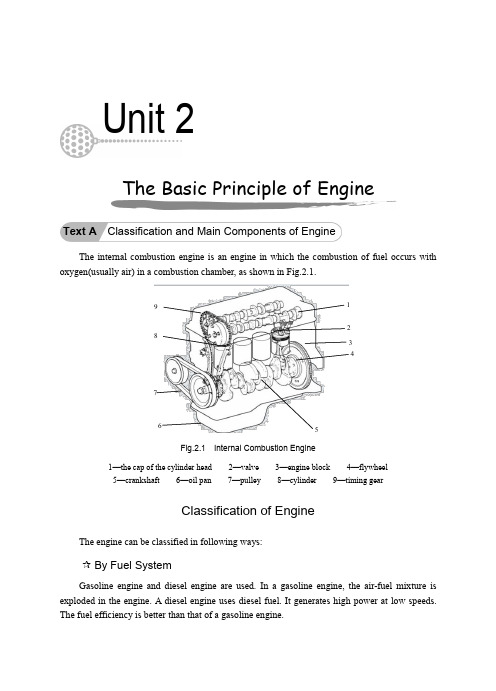
Unit 2The Basic Principle of EngineText A Classification and Main Components of EngineThe internal combustion engine is an engine in which the combustion of fuel occurs with oxygen(usually air) in a combustion chamber, as shown in Fig.2.1.1 87692 3 45Fig.2.1 Internal Combustion Engine1—the cap of the cylinder head 2—valve 3—engine block 4—flywheel 5—crankshaft 6—oil pan 7—pulley 8—cylinder 9—timing gearClassification of EngineThe engine can be classified in following ways:By Fuel SystemGasoline engine and diesel engine are used. In a gasoline engine, the air-fuel mixture is exploded in the engine. A diesel engine uses diesel fuel. It generates high power at low speeds. The fuel efficiency is better than that of a gasoline engine.Unit 2 The Basic Principle of Engine✩ By Cylinder Arrangemen tMost cars have more than one cylinder. Four, six and eight cylinders are common used. In a multi-cylinder engine, the cylinders are usually arranged in one of three ways: in-line, V-type, or flat (Fig.2.2). Today the number of cylinders is growing, the cylinders also can be arranged as W-type.(a) flat (b) V-type (c) in-lineFig.2.2 Cylinder Arrangement✩ By Cooling SystemLiquid-cooled engines and air-cooled engines are being used. Liquid-cooled engines are the most common in the engine industry.There are also other ways to classify the engines. Despite of these classifications, the structure of the engine is basically the same.Main ComponentsThe engine consists of several different mechanisms and systems including cylinder block, crankshaft and connecting rod mechanism, valve mechanism, fuel supply system, lubrication system, cooling system, ignition system and starting system.✩ Cylinder BlockThe core of the engine is the cylinder, with the piston moving up and down inside the cylinder.✩ Crankshaft and Connecting Rod MechanismThe crankshaft changes the linear movement of the piston into a rotational movement via a connecting rod. The connecting rod connects the piston to the crankshaft. It can rotate at both ends so that its angle can change as the piston moves and the crankshaft rotates.✩ Valve MechanismA valve mechanism is a group of components that opens and closes the intake and exhaust valves in the cylinder head at the appropriate time. The main functions of the valve gear are to provide timely admission of the fresh charge into the cylinders and exhaust of spent gases from them.1112汽车专业英语✩ Fuel Supply SystemThe fuel system supplies fuel to the engine. It also has the functions to regulate the volume of fuel supply. The fuel systems in diesel and gasoline engines are different.✩ Lubrication SystemThe lubrication system uses an oil pump to continuously supply engine oil throughout the inside of the engine. This system reduces friction between parts with a film of oil. If the engine is run without oil, the friction can cause poor running, or cause even meltdown. In addition to lubrication, engine oil cools and cleans the engine.✩ Cooling SystemThe cooling system regulates the engine temperature to an optimal level (80℃ to 90℃ at coolant temperature) by circulating the coolant throughout the engine under all operating conditions and during all seasons of the year. The cooling fan cools the coolant in the radiator and water pump circulates the coolant through the cylinder head and the cylinder block.✩ Ignition SystemInternal combustion engines require ignition of the mixture, either by spark ignition (SI) or compression ignition (CI).✩ Starting SystemThe starting system forces the engine to crank with an electric motor, and starts the engine.Text B Engine Operating PrinciplesA four-stroke engine, also known as four-cycle, is an internal combustion engine in which the piston completes four separate strokes :intake, compression, power and exhaust —during two separate revolutions of the engine’s crankshaft, and one single thermodynamic cycle.The main parts in four stroke engine are shown in Fig.2.3.Fig.2.3 Main Parts in Four Stroke Engine1—intake valve 2—spark plug 3—exhaust valve 4—combustion chamber 5—piston head13Unit 2 The Basic Principle of EngineAs their name implies, four-stroke internal combustion engines have four basic steps that repeat with every two revolutions of the crankshaft:① Intake stroke ② Compression stroke, ③ Power stroke, ④ Exhaust stroke. The four strokes will be illustrated in Fig.2.4.They draw in an air-fuel mixture to the cylinders, compress it, ignite and combust it, then discharge it. Repeating these four actions gives gasoline engines their power. The cycle begins at Top Dead Centre (TDC), when the piston is farthest away from the crankshaft. A cycle refers to the full travel of the piston from TDC to Bottom Dead Centre (BDC).✩ Intake StrokeOn the intake stroke of the piston, the piston descends from (TDC,BDC) to (TDC, BDC), reducing the pressure inside the cylinder. A mixture of fuel and air, or just air in a diesel engine, is forced by atmospheric pressure into the cylinder through the intake port. The intake valve(s) then (open,close).✩ Compression StrokeWith both intake and exhaust valves (open,close), the piston returns to the top of the cylinder compressing the fuel-air mixture into the combustion chamber of the cylinder head.✩ Power StrokeIt is also named as combustion stroke. While the piston is close to (TDC,BDC), the compressed air –fuel mixture is ignited. The resulting massive pressure from the combustion of the compressed fuel-air mixture forces the piston back down toward (TDC,BDC).✩ Exhaust StrokeDuring the exhaust stroke, the piston once again returns to (TDC,BDC) while the exhaust valve is (open,close). This action evacuates the burnt products of combustion from the cylinder by expelling the spent fuel-air mixture out through the exhaust valve(s)..(1) intake (2) compression (3) power (4) exhaustFig.2.4 Four Stroke Cycle汽车专业英语NEW WORDS AND PHRASESprinciple [ ] n. 原理,法则classification [ ] n. 种类,类别configuration [ ] n. 布局,构造oxygen [ ] n. 氧气combustion [ ] n. 燃烧chamber [ ] n. 室,房间component [ ] n. 成分,部件,零件force [ ] n. 力gasoline [ ] n. 汽油diesel [ ] n. 柴油;柴油机explode [ ] n. 爆炸,爆发rotational [ ] adj. 旋转的in-line [ ] adj. (汽缸)直列的flat [ ] adj. (汽缸)水平对置cooling system 冷却系liquid-cooled 水冷air-cooled 风冷cylinder block 汽缸体crankshaft [ ] n. 曲柄轴,机轴connecting rod 连杆valve mechanism [ ] 配气机构fuel supply system 燃油供给系lubrication[ ] 润滑lubrication system 润滑系ignition system 点火系starting system 起动系linear [ ] adj. 线性的piston [ ] n. 活塞intake [ ] n. 吸入;进气口,入口exhaust [ ] n. 排气;废气valve [ ] n. 气门,阀门oil pump 机油泵friction [ ] n. 摩擦(力)part [ ] n. 零件, 部位appropriate [ ] adj. 恰当的,适当的14Unit 2 The Basic Principle of Enginevolume [ U.S. ] n. 容量,容积a film of oil 一层油膜meltdown [ ] n. 熔毁optimal [ ] adj. 最佳的,最优的coolant [ ] n. 冷却液,冷冻剂radiator [ ] n. 散热器water pump 抽水机,水泵spark ignition (SI) 火花点火compression [ ] ignition (CI) 压缩点火four-stroke 四冲程的(内燃机)power [ ] n. 做功illustrate[ ] vt. 说明,阐明revolution [ ] n. 旋转(一周)spark plug 火花塞discharge [ ] vt. 释放;排出Top Dead Centre (TDC) 上止点Bottom Dead Centre (BDC) 下止点descend [ ] vi. 下降,降临evacuate [ ] vi. 散离,释放NOTES TO THE TEXT1. The internal combustion engine is an engine in which the combustion of fuel occurs with oxygen(usually air) in a combustion chamber.内燃机是一种由燃料和氧气(通常是空气)在燃烧室中燃烧而产生动力的发动机。
专业外语(车辆工程)

bore 孔、镗孔、缸径 bored /boring 镗孔的 boring cutter 镗刀 align bored 同心镗
bolt 螺栓; nut 螺母 ;thread 螺纹 screw 螺钉;cap screw 有帽螺钉 press fit 过盈配合、紧配合 loose fit 间隙配合、松配合
3.2 Manual Transmission
drive line 动力传动系统 transmission=gearing box 变速器 gearing 档位 gear shift mechanism 换挡机构 input shaft 输入轴 output shaft 输出轴 countershaft 中间轴 main gearing 主变速器 auxiliary gearing 副变速器 reverse 反转,倒档 overdrive gearing 超速档 idler shaft 惰轮轴 neutral 空档
3.4.2 Drive Shaft
2.1.5 Valve
valve 气门 valve guide 气门导管 valve seat 气门座 valve stem 气门杆 valve lifter 气门挺柱 valve clearance 气门间隙 spring retainer 弹簧支座 heat capacity 热容量、比热 heat resistance metal 耐热钢 bearing journal 轴颈 timing gear 正时齿轮
3.4.1 Axles
heavy-duty truck 重型载货汽车 driving axle 驱动桥 steering axle 转向桥 trailer axle 拖车桥 axle shafts=axles 驱动桥半轴 differential carrier assembly 差速器总成 differential case 差速器壳体 rear axle assembly 后桥总成 double reduction axle双级减速驱动桥 semi-floating type axle 半浮式车桥 fully floating type axle 全浮式车桥 differential spider 差速器十字轴 differential pinion gear 差速器行星齿轮
车辆工程专业英语概述
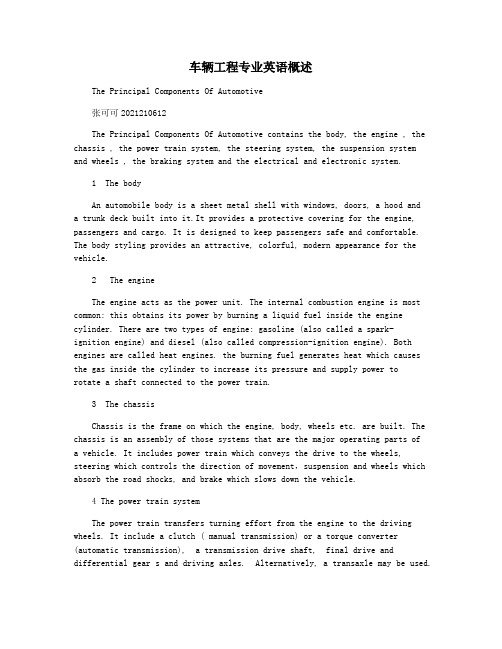
车辆工程专业英语概述The Principal Components Of Automotive张可可2021210612The Principal Components Of Automotive contains the body, the engine , the chassis , the power train system, the steering system, the suspension system and wheels , the braking system and the electrical and electronic system.1 The bodyAn automobile body is a sheet metal shell with windows, doors, a hood anda trunk deck built into it.It provides a protective covering for the engine, passengers and cargo. It is designed to keep passengers safe and comfortable. The body styling provides an attractive, colorful, modern appearance for the vehicle.2 The engineThe engine acts as the power unit. The internal combustion engine is most common: this obtains its power by burning a liquid fuel inside the engine cylinder. There are two types of engine: gasoline (also called a spark-ignition engine) and diesel (also called compression-ignition engine). Both engines are called heat engines. the burning fuel generates heat which causes the gas inside the cylinder to increase its pressure and supply power torotate a shaft connected to the power train.3 The chassisChassis is the frame on which the engine, body, wheels etc. are built. The chassis is an assembly of those systems that are the major operating parts ofa vehicle. It includes power train which conveys the drive to the wheels, steering which controls the direction of movement,suspension and wheels which absorb the road shocks, and brake which slows down the vehicle.4 The power train systemThe power train transfers turning effort from the engine to the driving wheels. It include a clutch ( manual transmission) or a torque converter (automatic transmission), a transmission drive shaft, final drive and differential gear s and driving axles. Alternatively, a transaxle may be used.A transaxle is a self-contained unit with a transmission, final drive gears and differential located in one casing.The directional motion of vehicle is controlled by a steering system. A basic steering system has 3 main parts: a steering box connected to the steering wheel, the linkage connecting the steering box to the wheel assembly at the front wheels and front suspension parts to let the wheel assemblies pivot. When the driver turns the steering wheel,a shaft from the steering column turns the steering gear. The steering gear movestie-rods that connect to the front wheels. The tie-rods move the front wheels to turn the vehicle right or left.5 The braking system and wheelsThe purpose of the complete suspension system is to isolate the vehicle body from road shocks and vibrations, which will otherwise be transferred to the passengers and load. It must also keep the tires in contact with the road regardless of road surface. A basic suspension system consists of springs, axles, shock absorbers, arms, rods and ball joints.The tire provides a cushion between the vehicle and the road to reduce the transmission of road shocks. It also provides friction to allow the vehicle to perform its normal operations. Modern tires are manufactured from a range of materials. The rubber is mainly synthetic. Two types of tire construction are common: cross-ply and radial. Most passenger cars now use radial tires, and radials are replacing cross-ply tires on 4-wheel drives and heavy vehicles.6 The braking systemDrum brakes have a drum attached to the wheel hub, and braking occurs by means of brake shoes expanding against the inside of the drum. With disc brakes, a disc attached to the wheel hub is clenched between two brakepads. On lightvehicles, both of these systems are hydraulically operated. The brake pedal operates a master cylinder. Hydraulic lines and hoses connect the master cylinder to brake cylinders at the wheels. Most modern light vehicles have either disc brakes on the front wheels and drum brakes on the rear or disc brakes on a11 4 wheels. Disc brakes require greater forces to operate them. A brake booster assists the driver by increasing the force applied to the master cylinder when the brake is operated.7 The electrical and electronic systemThe charging system provides electrical energy for all of the electrical components on the vehicle. A typical charging system includes: a battery, an alternator, a voltage regulator which is usually integral to the alternator, a charging warning or indicator light and wiring that complete the circuits. The battery provides electrical energy for starting, then once the engine is running the alternator powers all the electrical components of the vehicle. The alternator also charges the battery to replace the energy used to start the engine. The voltage regulator prevents overcharging. The starting system consists of the battery, starter, flywheel ring gear, cables,and the ignition switch. The starter motor is powered by the battery. During starting, the pinion of the starter motor engages withthe flywheel ring gear and the starter motor then operates to crank the engine.Electrical is related to the electricity while electronic related to the semi-conductor or microcomputers. The electrical system provides electricity to the starter, ignition, lights and heater. The electricity level is maintained by a charging circuit.That's all.感谢您的阅读,祝您生活愉快。
车辆工程专业英语——新能源汽车综述完整

车辆工程专业英语——新能源汽车综述(优质文档,可直接使用,可编辑,欢迎下载)Characteristics and Development of Some Kinds of New Energy VehiclesAbstractNow the global automotive industry is facing the challenge of energy and environment,and developing new energy vehicles becomes many global automotive groups’s same plan。
But not all of various types of new energy vehicles which have their own advantages and disadvantages can become the most promising future vehicles.I will introduce features and development of Pure Electric Vehicles 、Hybrid Electric Vehicle (HEV)、Fuel Cell Electric Vehicles (FCEV)、Natural Gas Vehicles、Hydrogen Engine Vehicles and DME Vehicles Etc。
At last we will know which kind of the new energy vehicles will become mainstream in the future of the car by comparing.Key Word:New Energy Vehicles Future cars HybridHybrid cars is hybrid electric vehicles which use more than one kind of energy provides power to drives the car . Currently hybrid cars is the combination of traditional fossil fuels engin and electric motor.The most prominent advantage of hybrid cars is its fuel economy。
- 1、下载文档前请自行甄别文档内容的完整性,平台不提供额外的编辑、内容补充、找答案等附加服务。
- 2、"仅部分预览"的文档,不可在线预览部分如存在完整性等问题,可反馈申请退款(可完整预览的文档不适用该条件!)。
- 3、如文档侵犯您的权益,请联系客服反馈,我们会尽快为您处理(人工客服工作时间:9:00-18:30)。
The Principal Components Of Automotive张可可2013210612 The Principal Components Of Automotive contains the body, the engine , the chassis , the power train system, the steering system, the suspension system and wheels , the braking system and the electrical and electronic system.1 The bodyAn automobile body is a sheet metal shell with windows, doors, a hood and a trunk deck built into it.It provides a protective covering for the engine, passengers and cargo. It is designed to keep passengers safe and comfortable. The body styling provides an attractive, colorful, modern appearance for the vehicle.2 The engineThe engine acts as the power unit. The internal combustion engine is most common: this obtains its power by burning a liquid fuel inside the engine cylinder. There are two types of engine: gasoline (also called a spark-ignition engine) and diesel (also called compression-ignition engine). Both engines are called heat engines. the burning fuel generates heat which causes the gas inside the cylinder to increase its pressure and supply power to rotate a shaft connected to the power train.3 The chassisChassis is the frame on which the engine, body, wheels etc. are built. The chassis is an assembly of those systems that are the major operating parts of a vehicle. It includes power train which conveys the drive to the wheels, steering which controls the direction of movement,suspension and wheels which absorb the road shocks, and brake which slows down the vehicle.4 The power train systemThe power train transfers turning effort from the engine to the driving wheels. It include a clutch ( manual transmission) or a torque converter (automatic transmission), a transmission drive shaft, final drive and differential gear s and driving axles. Alternatively, a transaxle may be used. A transaxle is a self-contained unit with a transmission, final drive gears and differential located in one casing.The directional motion of vehicle is controlled by a steering system. A basic steering system has 3 main parts: a steering box connected to the steering wheel, the linkage connecting the steering box to the wheel assembly at the front wheels and front suspension parts to let the wheel assemblies pivot. When the driver turns the steering wheel,a shaft from the steering column turns the steering gear. The steering gear movestie-rods that connect to the front wheels. The tie-rods move the front wheels to turn the vehicle right or left.5 The braking system and wheelsThe purpose of the complete suspension system is to isolate the vehicle body from road shocks and vibrations, which will otherwise be transferred to the passengers and load. It must also keep the tires in contact with the road regardless of road surface. A basic suspension system consists of springs, axles, shock absorbers, arms, rods and ball joints.The tire provides a cushion between the vehicle and the road to reduce the transmission of road shocks. It also provides friction to allow the vehicle to perform its normal operations. Modern tires are manufactured from a range of materials. The rubber is mainly synthetic. Two types of tire construction are common: cross-ply and radial. Most passenger cars now use radial tires, and radials are replacing cross-ply tires on 4-wheel drives and heavy vehicles.6 The braking systemDrum brakes have a drum attached to the wheel hub, and braking occurs by means of brake shoes expanding against the inside of the drum. With disc brakes, a disc attached to the wheel hub is clenched between two brakepads. On lightvehicles, both of these systems are hydraulically operated. The brake pedal operates a master cylinder. Hydraulic lines and hoses connect the master cylinder to brake cylinders at the wheels. Most modern light vehicles have either disc brakes on the front wheels and drum brakes on the rear or disc brakes on a11 4 wheels. Disc brakes require greater forces to operate them. A brake booster assists the driver by increasing the force applied to the master cylinder when the brake is operated.7 The electrical and electronic systemThe charging system provides electrical energy for all of the electrical components on the vehicle. A typical charging system includes: a battery, an alternator, a voltage regulator which is usually integral to the alternator, a charging warning or indicator light and wiring that complete the circuits. The battery provides electrical energy for starting, then once the engine is running the alternator powers all the electrical components of the vehicle. The alternator also charges the battery to replace the energy used to start the engine. The voltage regulator prevents overcharging. The starting system consists of the battery, starter, flywheel ring gear, cables,and the ignition switch. The starter motor is powered by the battery. During starting, the pinion of the starter motor engages withthe flywheel ring gear and the starter motor then operates to crank the engine.Electrical is related to the electricity while electronic related to the semi-conductor or microcomputers. The electrical system provides electricity to the starter, ignition, lights and heater. The electricity level is maintained by a charging circuit.That's all.。
